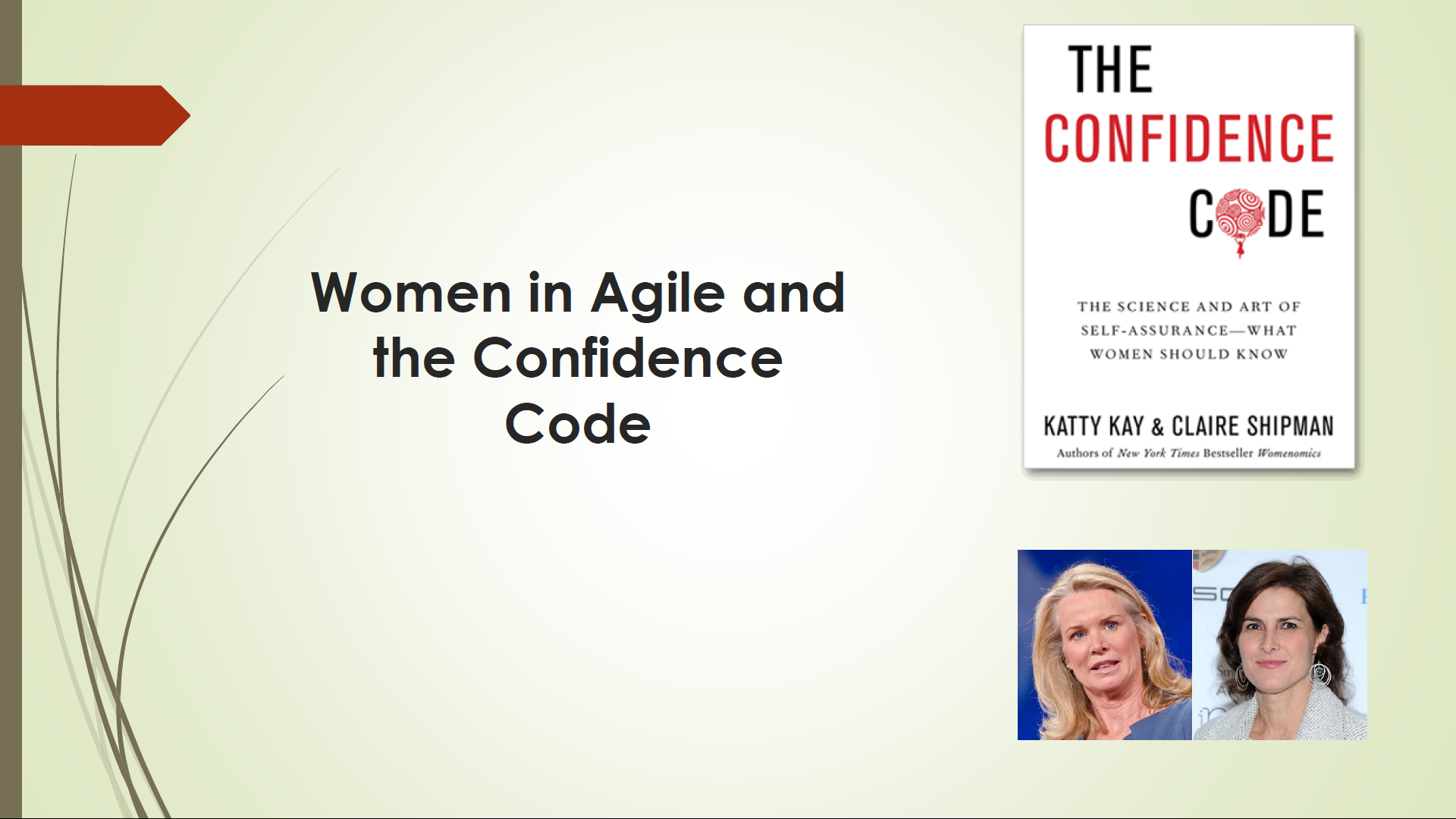So, the last speaker of the last day. Wow. I don’t know about you, but I’m tired. I’ve had a lot going on at work, a lot of unplanned work. I’ve got a little bit of a scratchy throat, so I’ve got my water down here. A little bit of a cough—so bear with me.
I’ve watched some great speakers up here. They’ve walked around with this wonderful choreography—perfectly timed, perfectly memorized. You’re not going to get that from me today. I’m going to rely on my notes because I want to make sure you get everything I want to share with you.
The Book That Inspired This Talk
My talk is based on a book I read called The Confidence Code. The full title is The Confidence Code: The Science and Art of Self-Assurance—What Women Should Know by Katty Kay and Claire Shipman. As I was reading it, I thought, “Wow, this could be a cool talk.” I talked to some Agile coaches, and they agreed.
So, I also interviewed some key women in Agile to get their experiences and observations on the confidence gap. I spoke to Lisa Adkins, Esther Derby, Ellen Grove (who is actually one of the organizers of this conference—there she is back there!), and Kat Conner, an executive at SolutionsIQ. My goal was to see how their insights aligned with what I was learning from the book—and it really did.
Where Does Confidence Come From?
How many people think confidence is something we’re born with? That it’s genetic? A few of you? Well, only slightly. Genetics play a really small role in how we build confidence over time.
Confidence requires choice. It requires focusing less on people-pleasing and perfection, and more on action, risk-taking, and fast failures. Sound familiar? Those last three words should resonate with this audience—action, risk-taking, and fast failures. That’s why confidence can sometimes feel harder for women. These behaviors aren’t traditionally encouraged for them as they are for men.
The Impact of Socialization
I asked Ellen Grove, “Do you believe confidence manifests itself differently in men and women? If so, why?” Here’s what she said:
“Yes, I do. Maybe not from my own experiences, but from what I’ve observed. Men and women are socialized differently, which affects how confidence is perceived.”
Hold onto that phrase—how confidence is perceived. We’ll come back to it later.
Ellen pointed out that behaviors associated with confidence—talking authoritatively, firmly expressing opinions, or making strong declarations—are often encouraged in men but discouraged in women. Traditional female roles—like teachers and nurses—emphasize listening, support, and collaboration. While these are valuable skills, they don’t always align with the traditional Western perception of confidence.
Even small things play a role—physical presence, for example. Women tend to be more aware of their space, sitting demurely, while men are more comfortable taking up space. Have you ever noticed that women sometimes sound like they’re asking a question even when they’re making a statement?
Confidence and Early Conditioning
Carol Dweck once said, “If life were a long grade school, women would rule the world.” Think about that. What are we taught in grade school? Be polite, be nice, share. Girls pick up on emotional cues early and are rewarded for being "good." Boys, on the other hand, are encouraged to compete, be rowdy, and take risks. They often learn about conflict resolution through sports.
The problem is that girls aren’t encouraged to take risks and make mistakes—critical steps in building confidence.
The Role of Genetics
There is a small genetic factor. Scientists have identified what I’ll call the “anxiety gene.” This gene affects serotonin production—the more serotonin you produce, the less anxious you are.
Most people have a medium-sized version of this gene. Some are lucky and have the long version, which helps them handle anxiety well. Others have the short version, making them more prone to anxiety.
But studies show that nurture plays a much bigger role than nature. In an experiment with monkeys, those with the short gene raised by anxious mothers remained anxious. But when raised by confident, nurturing mothers, they excelled.
Taking Risks: A Story
Let me tell you a story about Jane Wurwand. She’s now a skincare mogul, running Dermalogica. But when she was young, her father died suddenly. Her mother had to work, leaving Jane and her sisters to take care of themselves. On Jane’s first day of school, her mother tied the house key to a ribbon around her neck, walked her to school, and told her to remember the way home. She wasn’t even five years old.
Now, I’m not saying we should put our kids in danger, but this story highlights the importance of letting children take risks. Learning from hard experiences builds confidence.
Building Confidence
So how can we build confidence? Here are some key points from the book:
- Have a growth mindset. Many women tend to have a fixed mindset—"I’m good at this" or "I’m bad at that." Men are often more willing to believe they can learn anything. Mastery isn’t about being the best—it’s about learning and improving.
- Start small and fail fast. Sound familiar? That’s an ideal paradigm for building confidence.
- Take action. Stop overthinking and just do it.
Action vs. Overthinking
Esther Derby told me a story from her sailboat racing days. When men lost a race, they blamed external factors—wind, tides, bad conditions. When women lost, they blamed themselves—"If only I had done this differently."
Women often ruminate instead of analyzing external causes. The book calls these "negative automatic thoughts" or "gnats." You know, those little voices in your head saying, “What if I fail?” Shut them off. Channel them elsewhere. They prevent action.
Getting Help
Even the best need support. Lisa Adkins, author of Coaching Agile Teams, almost didn’t publish her book. She struggled with self-doubt. But she hired a personal and professional coach, which helped her push through. Sometimes, you need external support.
Confidence Is a Choice
Think about an emergency situation. A child is about to run into traffic. Do you stand there and analyze every possible action? No, you react. Confidence should work the same way—less overthinking, more action.
Confidence isn’t about being fearless. It’s about doing, working, deciding, and mastering. It’s about making choices. While confidence might look different in men and women, the impact is the same.
Final Thought
Confidence is a choice. You can choose to act, do, or decide.
Thank you.




